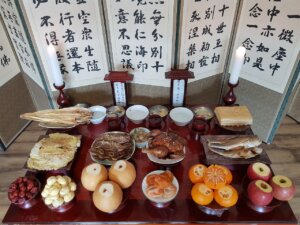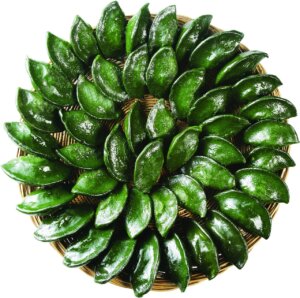Overview
- BTS JIN uploaded a message on weverse, celebrating Chuseok, the Korean Thanksgiving Day. He encouraged international ARMYs to try Songpyeon.
- In this article, we will explore the importance of Chuseok, delve into the traditions and activities linked to it, and gain an understanding of how this beloved holiday is perceived by people.

Table of Contents
1 Chuseok: Korean Thanksgiving
1.1 What is Chuseok?
1.2 Why Chuseok?
1.3 Customs and Activities
1.4 How Do People Think About Chuseok?
2 Songpyeon: The Delightful Korean Rice Cake
2.1 What us Songpyeon?
2.2 The Recipe: Crafting Songpyeon with Love
2.3 Why Songpyeon?
2.4 The Delight of Songpyeon
3 Conclusion
Chuseok, often referred to as Korean Thanksgiving Day, is a captivating celebration that offers a profound glimpse into Korean culture and tradition. For those intrigued by all things Korean, this holiday is a must-know event. In this post, we’ll delve into the significance of Chuseok, explore the customs and activities associated with it, and gain insight into how people perceive this cherished holiday.
1 Chuseok: Korean Thanksgiving
1.1 What is Chuseok?

Chuseok, known as 추석 in Korean, is one of the most important traditional holidays in South Korea. Falling on the 15th day of the 8th month of the lunar calendar, which usually aligns with late September to early October in the Gregorian calendar, Chuseok is a time for Koreans to express gratitude for the year’s bountiful harvest and to pay respects to their ancestors. Its roots can be traced back to ancient times when farming was the backbone of Korean society.
1.2 Why Chuseok?

Chuseok is deeply rooted in Korea’s agricultural heritage. In the past, a successful harvest was a matter of life and death for communities, so showing gratitude for the crops and the hard work of farmers was vital. This tradition has been passed down through generations, and Chuseok remains a time for Koreans to appreciate the abundance of nature and to reflect on their cultural heritage.
1.3 Customs and Activities

1. Charye (차례): Chuseok begins with a solemn ancestral ritual known as Charye. Families gather at their ancestral homes to offer food, drink, and other offerings to their deceased relatives. It’s believed that the spirits of ancestors return to the household during Chuseok to bless the living.
2. Seongmyo (성묘): Another significant tradition during Chuseok is Seongmyo, when families visit the graves of their ancestors. They clean the burial sites, offer food, and pay their respects. This practice demonstrates the importance of honoring one’s roots.
3. Songpyeon (송편): Chuseok is also renowned for its special food, most notably Songpyeon, a type of rice cake. Families come together to make and share these delicious treats, often in various vibrant colors and shapes. It’s a time for bonding and passing down culinary traditions.
4. Hanbok (한복): During Chuseok, it’s common to see people dressed in traditional Korean attire called Hanbok. This not only adds to the festive atmosphere but also underscores the connection to Korea’s rich cultural history.
5. Games and Activities: In addition to rituals and feasting, Chuseok offers various games and activities like Ganggangsullae (a traditional circle dance), archery, and wrestling, adding a joyful and communal aspect to the celebration.
1.4 How Do People Think About Chuseok?
Chuseok holds a special place in the hearts of Koreans, and its significance extends beyond a simple holiday. It’s a time for family reunions, for reaffirming cultural identity, and for expressing gratitude for the blessings of life. For many, Chuseok evokes a sense of nostalgia, as they remember childhood memories of making Songpyeon with their grandparents or playing traditional games with cousins.
In modern times, Chuseok has also become an occasion for Koreans to take a break from their busy lives, travel to their hometowns, or simply enjoy quality time with loved ones. While the importance of agriculture has waned with urbanization, the spirit of gratitude and the deep-rooted respect for ancestors still resonate strongly.
2 Songpyeon: The Delightful Korean Rice Cake
2.1 What is Songpyeon?

Songpyeon (송편) is a delectable Korean rice cake with a unique charm that extends far beyond its delightful taste. This colorful and crescent-shaped treat is an essential part of Chuseok celebrations, and its preparation and consumption are steeped in tradition and symbolism.
2.2 The Recipe: Crafting Songpyeon with Love
Making Songpyeon is not just about preparing a delicious dessert; it’s a cherished cultural practice that brings families together. Here’s how it’s traditionally crafted:
Ingredients:
1. Glutinous Rice Flour (찹쌀가루): The foundation of Songpyeon is glutinous rice flour, which gives it its distinctive chewy texture.
2. Water: To mix with the rice flour and create the dough.
3. Sesame Oil (참기름): Used to prevent the dough from sticking and to enhance flavor.
4. Fillings: Songpyeon can be filled with various ingredients like sweetened sesame seeds, honey, red bean paste (pat, 팥), or chestnuts.
5. Food Coloring: Traditionally, natural ingredients like spinach or mugwort were used to color the dough. However, nowadays, food coloring is more common.



